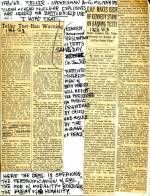|
Negotiations for some sort of ban on the testing of nuclear weapons continued in Geneva
through 1962 and into 1963, with little to show. Then came great and unexpected news.
On June 10, President Kennedy announced that the US would stop its atmospheric tests
as a sign of support for the talks. A few weeks later, Khrushchev signaled back, saying
that the USSR was in favor of a "partial test ban," one that would get around the
difficulties of detecting underground blasts by exempting them. In other words, the
nuclear nations would be able to continue to test their weapons, as long as they released
no fallout into the atmosphere. After that, things started moving quickly. On August
5, after five years of negotiations, the US and USSR signed a treaty to ban all tests
of nuclear weapons in the atmosphere, outer space, and under the sea. This "partial
test ban" was the first significant weapons-limitation treaty of the Cold War, "a
shaft of light," as Kennedy put it. He signed the treaty on October 7. Everyone was
pleased with the development, including Pauling, who wrote Schweitzer that he was
"very happy" about its ratification. It was not an end to war, but it was an important
step in the right direction.
|
|
Click images to enlarge

Promotional flyer for Linus Pauling's Verve recording on fallout and nuclear warfare. 1960.

Notes by Linus Pauling. February 1, 1963.
"No one would suggest that the nuclear test ban is the sole work of Linus Pauling.
But does anyone believe that the treaty would have been reached if there had been
no responsible scientists who, tirelessly, unflinchingly, year in and year out, impressed
on the authorities and on the general public the real menace of nuclear tests?"
|

